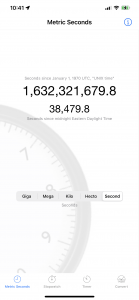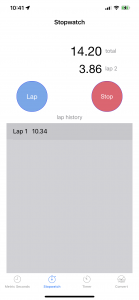Metric Seconds 1.1 for iOS
- Stopwatch and timer screens are easier to use now.
- UI improvements such as supporting dark mode.
- Removed all logging to increase user privacy.
- And the usual bug fixes and performance improvements!
I don’t like it. Sixty seconds per minute, sixty minutes per hour, 24 hours per day, seven days per week. And weeks or days per month? Ridiculous. Let’s face it: Time keeping is awkward, at least it is the way we do it.  And doing calculations with time is just painful. We’re still using the same time-keeping as the Babylonians. Or at least using their same numbering system.
And doing calculations with time is just painful. We’re still using the same time-keeping as the Babylonians. Or at least using their same numbering system.
So I wanted to do something about it. We already have a solution to this problem in other forms of measurement: The metric system that most of the world has adopted. We use meters, liters, centigrade and metric units to make conversions and measurement easy. So why not use metric time? Metric seconds! After all, seconds is the standard unit of time just as the meter is the standard for length. No, I don’t really think this’ll get adopted. Let’s face it: 86,400 seconds for the length of a day isn’t a handy number. But this is an interesting to try.
The Metric Seconds app lets you try out metric seconds for timekeeping and experiment with it for yourself. It shows you both the full metric seconds (no timezone, or alternately, it’s all on the UTC timezone) or just the metric seconds for today (in your timezone, if you want to do timezones!). The timer and stopwatch function on a metric second basis too. And the convert screen lets you figure out durations of time between metric and the crazy units that you and I are already used to.
 The ma
The ma in page (far left) shows you the current metric time. It also shows you the count of seconds for the day in your time zone too. The units let you view the time in that metric unit. The circle “i” in the upper right is an information page that tells you something about metric time and some equivalences.
in page (far left) shows you the current metric time. It also shows you the count of seconds for the day in your time zone too. The units let you view the time in that metric unit. The circle “i” in the upper right is an information page that tells you something about metric time and some equivalences.
The stopwatch page (left) is a simply a stopwatch using metric seconds. It includes a lap timer too. It’s buttons will change as necessary with as the stopwatch is started, pause, stopped, or reset.
See the app store for more screens:
Background:
Of course our current timekeeping system wasn’t exactly carefully designed. Like a lot of things it just sort of grew haphazardly as we needed it. We use 60 second/minute and 60 minutes/hour from the Sumerians who liked base 60. (It made sense at the time. There were a lot of factors of 60 that made their arithmetic easier.) The ancient Egyptians came up with the 24 hour day. The months are named after Roman gods and the days in a month came from the Greeks and Romans too. The seven days in the week came from the Babylonians who tied them to the seven visible planets. The calendar got revised several times since our planet’s year isn’t an even number of days long. Ok, frankly it’s a kludged up mess.
With computers we got to rethink it. Unix computers needed to track time and so we started keeping time in seconds. The zero point was arbitrarily set at the beginning of January 1, 1970. This has expanded to a time-keeping network protocol and now most computer systems keep time this way. So why don’t we just use this with metric units for timekeeping in general?
For some purposes second-based metric time makes sense. Like in engineering or scientific purposes and doing calculations with time. Or, while figuring pace while running. Doing the math with minutes and seconds math is hard enough normally. But while oxygen deprived while running? I don’t know about you, but my mental math abilities can be challenged during a run.
FAQ
- Why seconds? Seconds are a base unit and are the only time unit defined as a standard.
- Why do seconds start at January 1, 1970? This was used in the UNIX system originally. And as UNIX was adopted more widely in the computing field, this became a standard. The zero value is somewhat arbitrary since we can use negative and positive seconds and it was convenient for when UNIX was started. It’s important to be consistent though, even if the starting point is a bit arbitrary.
- What is a leap second? In the 1940s we started to be able to tell time well enough to see that the earth’s rotation was slowly slightly over time. Leap seconds keep our accurate timekeeping matched with the less accurate wobbly speed of rotation of the earth.
- When were seconds first measured? Dutch scientist Christiaan Huygens in 1656 created a pendulum clock that was the first to be able to reliably track seconds. Although seconds were used earlier, the clocks were not reliable enough to use seconds consistently. And also before that people didn’t always agree that the “seconds” were always 1/60 of a minute.
- What about decimal time? Is this decimal time? No, it’s not. Decimal time is dividing the day in to ten hours. And each hour into ten parts, and so forth. A version of this system was briefly used in Revolutionary France for about a year starting in September 1794. They also used a different value of the second. China used a different decimal time system between 2000 and 1500 years ago that co-existed with a 12/24 hour system. And in 1998 Swatch introduced yet another decimal time system they called “Internet Time” that divided the day into 1000 minutes. Only the Chinese system saw any consistent use and no decimal time system is in use now. The various decimal time systems have some metric elements, but don’t have a standardized base unit or use metric prefixes.
- Why is there 60 minutes in an hour and 60 seconds in a minute? Medieval astronomers in the arabic world divided the day into hours and minutes based on the Babylonia astronomers who used measures of arc as the stars moved in the sky. So we have degrees, minutes, and seconds as measures of angle, and hours, minutes and seconds for time. Both are based on Babylonia base 60 numbering systems.